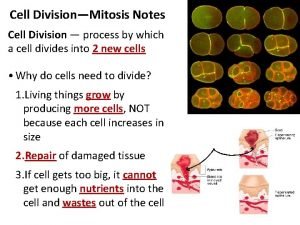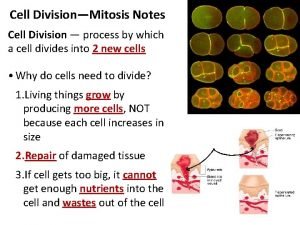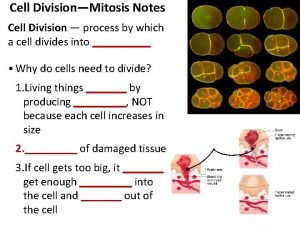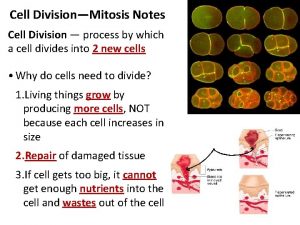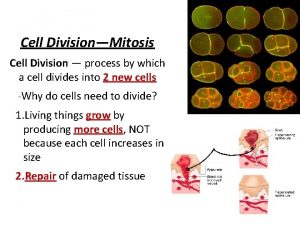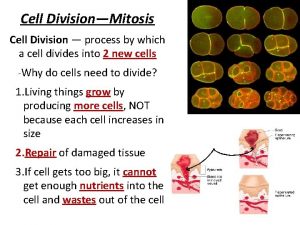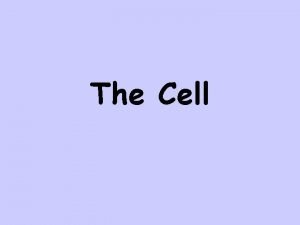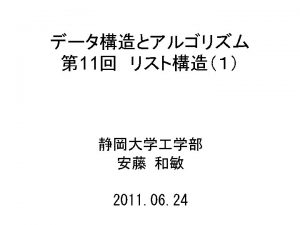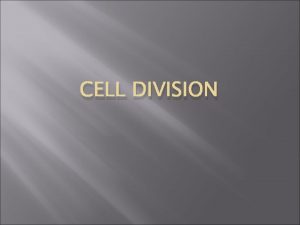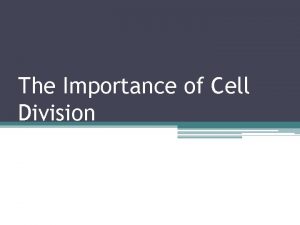1 6 Cell DivisionMitosis Question Why would a
























- Slides: 24

1. 6 Cell Division/Mitosis

Question? • Why would a cell want or need to divide? – Growth/development of tissues/organs – Repair of damaged tissue/organ – Reproduction of cells/organisms

Cell Cycle • The cell’s life cycle (usually just called the cell cycle) consists of two main parts: – Interphase – active period in the life of a cell when many metabolic reactions occur, including • protein synthesis • DNA replication • an increase in the number of mitochondria and/or chloroplasts – Mitosis – cell divides


Cell Cycle • Interphase can be divided into three phases: – G 1 – cell grows and metabolizes – S – DNA is replicated – G 2 – cell prepares for division

Mitosis • Mitosis can be divided into four stages: – Prophase – Metaphase – Anaphase – Telophase


Mitosis • Prophase – Nuclear envelope disappears – With the aid of special proteins called histones, DNA supercoils into distinct chromosomes that are visible under the microscope – Each pair of identical segments of DNA, called sister chromatids, bind together at the centromere to form one chromosome


Prophase – Centrioles moved to opposite ends of the cell – Long, tubular proteins called “spindle fibers” grow from the centrioles and attach to the centromeres of the chromosomes

Metaphase • Spindle fibers pull chromosomes to the equator (center line) of the cell

Anaphase • Spindle fibers shorten • Sister chromatids are pulled apart and are now called chromosomes • Chromosomes are pulled to opposite ends of the cell

Telophase • Reverse of prophase: – Spindle fibers dissapear – DNA uncoils and becomes chromatin – Nuclear envelope reforms

Cytokinesis – Splitting of the cytoplasm – Occurs when microtubule proteins pinch inward at the equator (cleavage furrow) – Results in two separate but identical cells

Plant Cell Division • In plants a cell plate forms instead of a cleavage furrow


Overview • Mitosis produces two genetically identical nuclei – During the S phase of interphase DNA is replicated to produce two identical copies – During prophase the identical copies of each chromosome (homologous chromsomes) bind together – Homologous chromosomes are pulled apart during anaphase and become part of two separate nuclei during telophase

• Mitosis serves many purposes: – Tissue/organ growth – Embryonic devleopment, when the zygote divides to produce many smaller cells – Tissue damage and repair – Asexual reproduction (unicellular organisms)

Control of this process • Cyclins – Series of proteins that control cells during cell cycle.

Not always controlled • Mutagens – – Physical or chemical agent that changes the DNA in an organism. – This increases the frequency of mutations in that organism above the natural background level. – Often these mutagens can cause cancer/tumors


Oncogenes • Sometimes the gene controlling cell division (called an oncogene) will become mutated • The result is that cell division continues repeatedly • This is how tumors are formed • Tumors can form in any tissue of the body Stomach Tumor

Metastasis • Greek for “Next Placement” • Cells that are going through uncontrolled proliferation can sometimes slough off of a tumor and spread through the body to another area that previously was unaffected. • These cells will continue their rapid mitotic division and cause the disease to spread.

Tumors • Tumors are a mass of cells that are going through mitosis uncontrollably due to a mutation in the DNA • Two major types: – Malignant: “Badly Born” can spread to invade other cells throughout the body. – Benign: lacks the ability to invade neighboring cells
 Pictures
Pictures I would rather negative form
I would rather negative form Would rather
Would rather 3 levels of questions
3 levels of questions Dont ask why why why
Dont ask why why why If+past perfect+would have+past participle examples
If+past perfect+would have+past participle examples Would sooner
Would sooner Question words present simple
Question words present simple Closed question
Closed question Contoh open-ended question
Contoh open-ended question Non researchable questions are answerable by yes or no
Non researchable questions are answerable by yes or no Question direct
Question direct Supporting questions for a compelling question
Supporting questions for a compelling question Example of a compelling question
Example of a compelling question Cell city analogy project
Cell city analogy project Difference between mercury cell and diaphragm cell
Difference between mercury cell and diaphragm cell Prokaryotic cell vs eukaryotic cell
Prokaryotic cell vs eukaryotic cell Prokaryotic and eukaryotic cells
Prokaryotic and eukaryotic cells Animal and plant cell venn diagram
Animal and plant cell venn diagram Ecell vs log cu2+
Ecell vs log cu2+ Dry cell vs wet cell
Dry cell vs wet cell Venn diagram for animal and plant cells
Venn diagram for animal and plant cells Cell wall function
Cell wall function Plant cell structure
Plant cell structure Cytosol plant cell
Cytosol plant cell

























